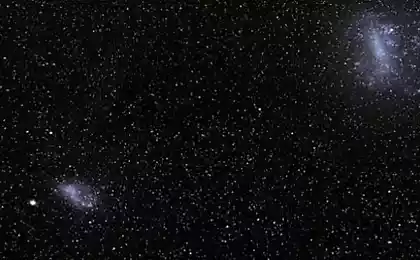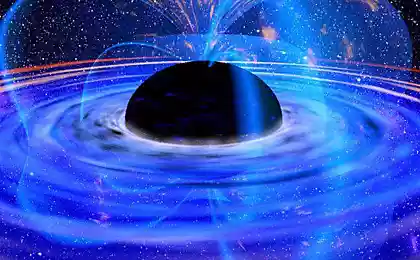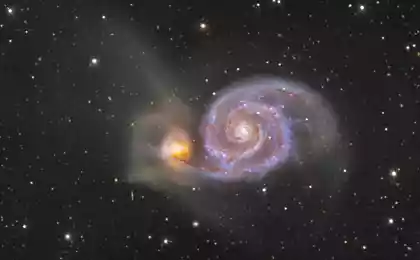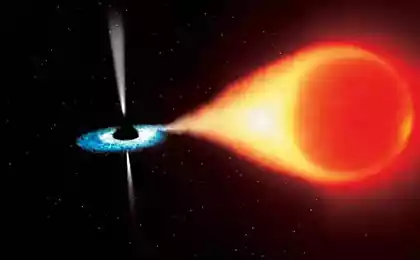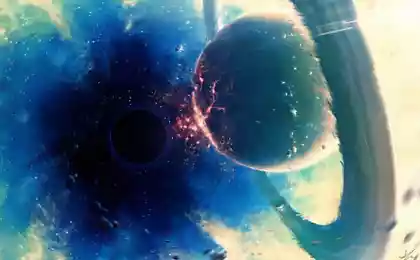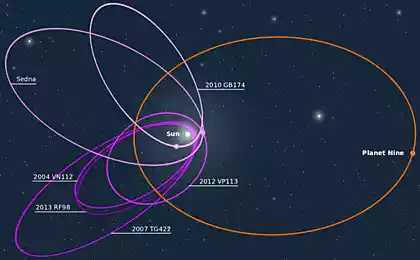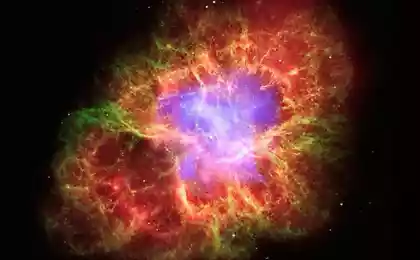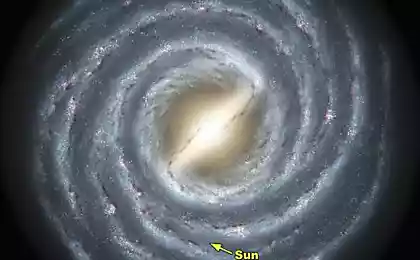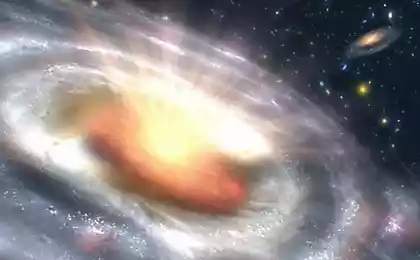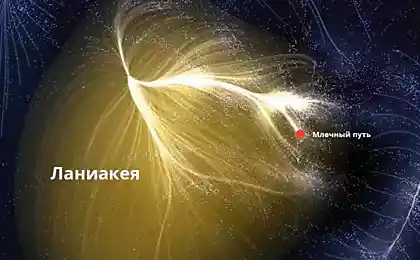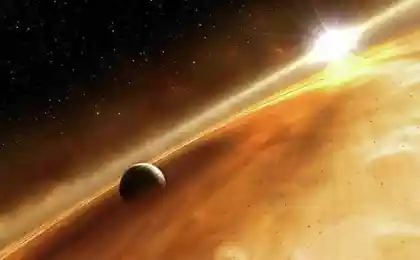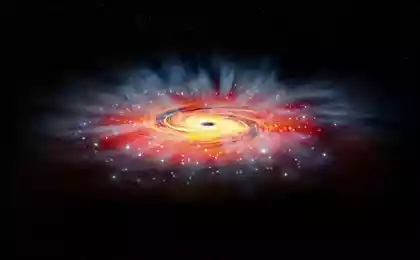1080
What would happen if the Solar system will be a black hole?
Seventy two million five hundred seventy one thousand two hundred forty three
Thought experiments is a good thing. We can imagine what would happen if the Moon disappears, and we suspect that our ancestors saw a supermassive black hole of the milky Way. Guess that the Moon has not always been cold and dead and Mars once flowed the rivers and the sea. But we are on the outskirts of the galaxy, and black holes to us almost do not exist. What if one of them was formed in the Solar system? Is this possible in principle?
In the night sky started to happen strange things. You, like many others, actively follow the news. The President, it is supported by astrophysicists, geologists and climatologists. He's nervous, but, paying tribute to the tradition, divides news into "bad" and "good". Good news: we're not dead, the planet is not destroyed, it was not taken in space and not hyped in the gravity wheel. Bad: we are waiting for "a very interesting climate change". Trying to survive near a black hole is similar to the escape from the Titanic — for a cold death in the ocean.
Before you reach for a suitcase or worrying will start to go crazy: don't worry, it's just a thought experiment. Black holes represent one of the most terrible phenomena in the Universe. Their enormous gravity bends space and time and our understanding of their nature — to the limit, to a single point. Supermassive black holes (like this one) lurk in the nuclei of galaxies, absorbing millions and billions of stars. The most accurate depiction of a black hole today, we watched the movie "interstellar". In fact, this phenomenon is many times worse.
What if not far from our Solar system to be born or show up black hole?
Greetings from бездны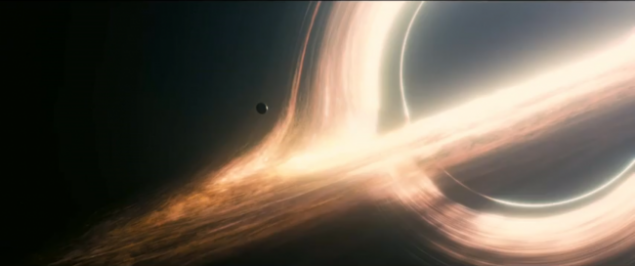
The most accurate to the moment the image of a black hole
Will have to understand in order. How close? Where? What is the mass?
It should be noted immediately that our Sun will never become a black hole. For this you need a mass order of a superior sunlight — 10-15 times. Then happens the gravitational collapse, and under the influence of gravity matter is literally collapses into a single point. A similar phenomenon lies at the basis of hydrogen bombs and in the theory of cold fusion, except gravity plays a different role. Moreover, the role of potential black holes are not suitable and other stars in nearby galaxies. Most of them are red dwarfs and have a mass in 8-60% of our Sun.
That leaves two possibilities: either a black hole spontaneously appears in our surroundings, or comes from nowhere. The first would be possible if all the fears over the Large hadron Collider made sense and the black hole created by artificial means. But no, that's impossible.
As for the second, astronomers and astrophysicists confirmed the existence of about 2,000 wandering black holes, but the chances that one of them will reach us, is nearing zero. And as noted by writer Douglas Adams:"Space is big. You just are not able to realize how incredible and mind-boggling big it is. I mean, it may seem a long road to the pharmacy, but by the standards of space seeds".
However, the probability of a black hole — very interesting event to pass.
Warp space and время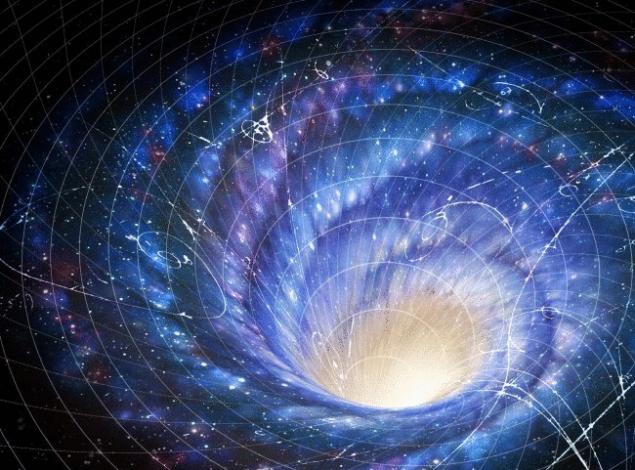
If you look at a black hole from afar, it will be similar to any other massive object. While it's right in front of you, she obeys the laws of classical mechanics and kutonova the law of universal gravitation, which States that the attraction between two objects is proportional to their mass and decreases with increasing distance. In other words, there is no gravitational difference between R136a1, blue dwarf star weighing 265 suns and a black hole with the same weight.
Go to the black hole closer, to get into its gravitational field, and you'll be faced with two different sets of rules. General theory of relativity, which admits the existence of black holes warp space and time, and extreme gravity, which brings a curvature to the extreme.
If you want to study a black hole, not getting out of the spaceship, you will find that the closer you are to the center of a huge mass, the more your engine will be straining to keep you on a circular orbit. The first small pulse rockets will be able to stabilize it; but the farther, the more energy you have to spend in order not to leave the orbit. As a result, only non-stop operation of engines of the rocket will separate you from the all-consuming nothing. However, in the film "interstellar" — and to the credit of Christopher Nolan and Kip Thorne these effects were shown to be surprisingly decent.
Once you run out of fuel (or you suddenly decide to shut down the engines), you cross the event horizon of a black hole boundary, which can not return even light. After that you will have to answer for their sins. Nothing will stop the inexorable March to the singularity of the kernel infinitely compressed space and time where physics as we know it, rolled into a ball and whimpers.
As you progress the time will slow down. Very much. From your point of view nothing will change, but your friends watching your trick, you will see something like greased lightning. But just before the event horizon — beyond beyond the light, and then to see you, no one can. The perfect crime, isn't it?
Gravitational bending of time — a phenomenon quite ordinary, but is too weak to be noticed. On Earth, for example, lived for a billion years at sea level, you will be a second younger than your age, lived on the summit of Everest. They say time fears the pyramids, but you will have to spend too much time leaning against her cheek to feel the slowing of time in Paris.
In a black hole time starts spinning. When we say that the fall in the singularity cannot be avoided, this means not only the inexorable action of gravity or distorted space. Time in a black hole is compressed to such an extent that the path to the singularity literally becomes your future. An escape from the singularity would be like trying to stop time.
What will happen to our Solar system, if it suddenly will feel the wrath of a black hole and fall into its whirlpool?
Time пришло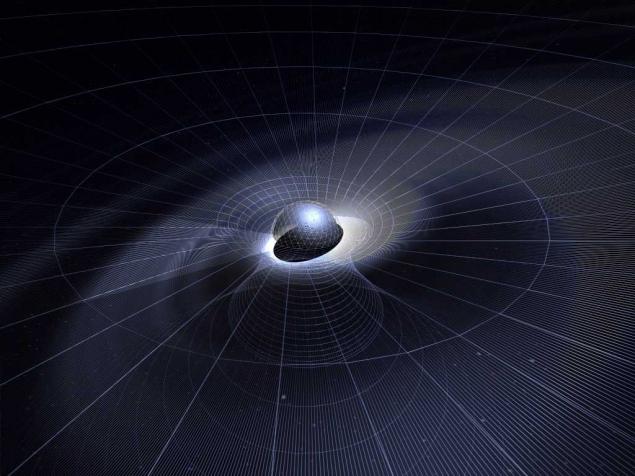
Let's say we have a black hole that is locked in a binary system in the arms of the star, which is preparing to become a supernova. All of a sudden this happens, the gravitational giant shoots our way at speeds of hundreds of kilometers per second. How would we know it?
The answer is simple: won't know until then, until he is confronted with something, since the massive gravity of black holes does not produce even light. So, instead of trying to find black pepper on the black carpet, let's look at some ways that will help us to directly determine black hole.
First, matter ripped a black hole will emit radiation as the rotation of the disk accretion. The space around will light up like a Christmas tree at night.
Secondly, the distortion of space around black holes can be detected by terrestrial methods. For example, using gravitational lensing, predicted in the framework of the General theory of relativity. The effect appears near a massive object and is recorded by astronomers. This is the same method used to search for dark matter.
But even under perfect conditions to detect a black hole this way would harder than finding a flea on a speckled dog at night with binoculars. With the eye patch. For the success of gravitational lensing black hole must pass between us and the star. And then we still have to get lucky.
In addition, the black hole can be felt, if it is to interact with gravity celestial objects like planets, stars, asteroids and comets, which again brings us to a key question: how close will be our hypothetical black hole lurking in the neighborhood?
Of course, the closer, the more dangerous. The closer the orbits of the planets and moons will dance dance like a Sparrow caught in a spider's web, dragging curves of the orbit and in violation of the order, which is trying to collect the parts since the days of Nicolaus Copernicus.
Here on Earth, would have changed the tides, and the tides and the color of the sky. If gravity, how to order Zhirinovsky, alienate the orbit of the planet further from the Sun, bring it, make it more elliptical, at best we will suffer from temperature extremes and oddities with the seasons. In the worst case (in addition to being part of the black hole) the Earth can fall into the Sun or go on a long voyage into the depths of space, dooming us all to a cold death.
Renowned astrophysicist Neil degrasse Tyson once aptly expressed the problems that will arise if near gets a "black guest": "If we visit the black hole, the Solar system would be a bad day."
Well, since we're doomed, let's gather the courage to dive towards the singularity.
Good and bad новости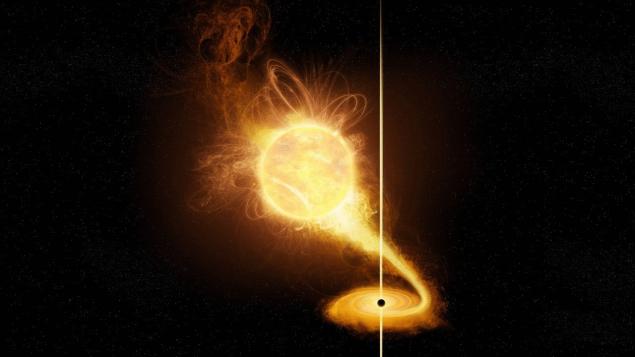
In Russian language there is a word of six letters that best describe what awaits us. Let's just call it desperation. Scientists learned how to divide by zero, and we were in a black hole. Even Bruce Willis with a brave crew of oil workers held a special training in Chelyabinsk, would not have saved us.
There was a black hole in the vicinity of Neptune, we would have immediately felt it. Scientists know the orbit of Neptune so well that they can detect even a deviation of 1 arcsecond (a unit of angular measure). A normal black hole with a mass of ten suns, flying at a speed of 300 km/s, would give another a distance of one tenth of a light year.
And here's a final piece of good news: the black hole of this size will give us at least 100 years to finish their earthly business. Perhaps the danger of this magnitude will cease all earthly war or begin one global. Perhaps humanity will manage to destroy himself, once he learns that one hundred years later — all kaput. While it doesn't matter. If the hole will move slower, a fatal timeout will increase tenfold. And then time to build the ark or charges planetary suitcase with clothes should be enough.
As approach to Neptune, the black death pulls a gas giant from orbit. The planet begins to behave strangely: the farther from happening redshift — wavelength of its radiation, including light, goes into the red spectrum. As soon as Neptune is behind the black hole, gravitational lens pulled on a black sphere and wraps around her. When a planet appears again, already in front of us, her worried blue color shifting — the wavelength goes to this end of the spectrum.
The red and blue offset, as a rule, is a consequence of the removal or approximation of a stellar object towards us. Similar to the Doppler effect.
However, as a black hole "eats" the planet, the gas will be sucked into a gravitational spiral as sugar during the creation of cotton candy. From our point of view, the spiral will always go into the event horizon. But the light emitted by the death of Neptune, will be reflected from the black hole in negative, like the solar corona during the Eclipse.
The closer the black hole is to the Ground, the more will appear surrounding the distortion effect, as in a distorting mirror. All telescopes will only see a void in the center of a black hole.
If our black death is a supermassive black hole, history is already over, its event horizon will be five times bigger than the Solar system. But it's boring. Let's take a smaller example and try to see the insides of this monster.
On the other side of the horizon событий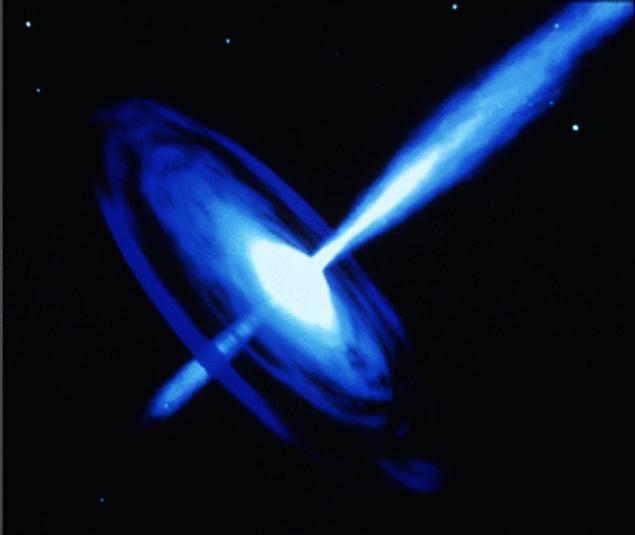
We are moving the rabbit hole, knowing your acquaintance with her will be very short. I hope that we will have time at least to assess the interior of a black hole. Luckily for us but unluckily for the Solar system, this black hole — supermassive. We changed the rules, but if we didn't, it would've ended for some reason.
In a small black hole, say with a mass of 30 suns — tidal forces caused by the increase in gravity would have torn us long before we reached the event horizon. But there gravity is around a million earth's. To enjoy the victory because we have reached the event horizon — we will not and 0.0001 seconds.
In a supermassive black hole with a mass of 5 million suns, like the one that located in the center of our galaxy, will be a totally different experience. Any black hole that has absorbed a lot more than 30 thousand suns, has a tidal forces since gravity is less than one earth on the horizon. We will have 16 seconds to look around (and change the rules of the game), before we reach the point of singularity. The greater the mass, the more time.
Falling through the event horizon like the process of falling asleep or falling in love: hard to define a reference point when it happens, but then your sense of reality will be completely different. In a black hole you'll see the stars (light gets inside, but not Vice versa), but the space around will resemble a soap bubble.
Well, after you crush to zero, you will get to a point of infinite curvature, where known to us the time and space comes to an end. And learn how physics works in this point of infinite curvature of time and space, infinite mass and density, we simply have no possibilities. Sometimes it seems that the heart of the black hole will reveal all the secrets of the Universe will raise an infinite number of questions. But it's all speculation. published
Source: hi-news.ru
Thought experiments is a good thing. We can imagine what would happen if the Moon disappears, and we suspect that our ancestors saw a supermassive black hole of the milky Way. Guess that the Moon has not always been cold and dead and Mars once flowed the rivers and the sea. But we are on the outskirts of the galaxy, and black holes to us almost do not exist. What if one of them was formed in the Solar system? Is this possible in principle?
In the night sky started to happen strange things. You, like many others, actively follow the news. The President, it is supported by astrophysicists, geologists and climatologists. He's nervous, but, paying tribute to the tradition, divides news into "bad" and "good". Good news: we're not dead, the planet is not destroyed, it was not taken in space and not hyped in the gravity wheel. Bad: we are waiting for "a very interesting climate change". Trying to survive near a black hole is similar to the escape from the Titanic — for a cold death in the ocean.
Before you reach for a suitcase or worrying will start to go crazy: don't worry, it's just a thought experiment. Black holes represent one of the most terrible phenomena in the Universe. Their enormous gravity bends space and time and our understanding of their nature — to the limit, to a single point. Supermassive black holes (like this one) lurk in the nuclei of galaxies, absorbing millions and billions of stars. The most accurate depiction of a black hole today, we watched the movie "interstellar". In fact, this phenomenon is many times worse.
What if not far from our Solar system to be born or show up black hole?
Greetings from бездны

The most accurate to the moment the image of a black hole
Will have to understand in order. How close? Where? What is the mass?
It should be noted immediately that our Sun will never become a black hole. For this you need a mass order of a superior sunlight — 10-15 times. Then happens the gravitational collapse, and under the influence of gravity matter is literally collapses into a single point. A similar phenomenon lies at the basis of hydrogen bombs and in the theory of cold fusion, except gravity plays a different role. Moreover, the role of potential black holes are not suitable and other stars in nearby galaxies. Most of them are red dwarfs and have a mass in 8-60% of our Sun.
That leaves two possibilities: either a black hole spontaneously appears in our surroundings, or comes from nowhere. The first would be possible if all the fears over the Large hadron Collider made sense and the black hole created by artificial means. But no, that's impossible.
As for the second, astronomers and astrophysicists confirmed the existence of about 2,000 wandering black holes, but the chances that one of them will reach us, is nearing zero. And as noted by writer Douglas Adams:"Space is big. You just are not able to realize how incredible and mind-boggling big it is. I mean, it may seem a long road to the pharmacy, but by the standards of space seeds".
However, the probability of a black hole — very interesting event to pass.
Warp space and время

If you look at a black hole from afar, it will be similar to any other massive object. While it's right in front of you, she obeys the laws of classical mechanics and kutonova the law of universal gravitation, which States that the attraction between two objects is proportional to their mass and decreases with increasing distance. In other words, there is no gravitational difference between R136a1, blue dwarf star weighing 265 suns and a black hole with the same weight.
Go to the black hole closer, to get into its gravitational field, and you'll be faced with two different sets of rules. General theory of relativity, which admits the existence of black holes warp space and time, and extreme gravity, which brings a curvature to the extreme.
If you want to study a black hole, not getting out of the spaceship, you will find that the closer you are to the center of a huge mass, the more your engine will be straining to keep you on a circular orbit. The first small pulse rockets will be able to stabilize it; but the farther, the more energy you have to spend in order not to leave the orbit. As a result, only non-stop operation of engines of the rocket will separate you from the all-consuming nothing. However, in the film "interstellar" — and to the credit of Christopher Nolan and Kip Thorne these effects were shown to be surprisingly decent.
Once you run out of fuel (or you suddenly decide to shut down the engines), you cross the event horizon of a black hole boundary, which can not return even light. After that you will have to answer for their sins. Nothing will stop the inexorable March to the singularity of the kernel infinitely compressed space and time where physics as we know it, rolled into a ball and whimpers.
As you progress the time will slow down. Very much. From your point of view nothing will change, but your friends watching your trick, you will see something like greased lightning. But just before the event horizon — beyond beyond the light, and then to see you, no one can. The perfect crime, isn't it?
Gravitational bending of time — a phenomenon quite ordinary, but is too weak to be noticed. On Earth, for example, lived for a billion years at sea level, you will be a second younger than your age, lived on the summit of Everest. They say time fears the pyramids, but you will have to spend too much time leaning against her cheek to feel the slowing of time in Paris.
In a black hole time starts spinning. When we say that the fall in the singularity cannot be avoided, this means not only the inexorable action of gravity or distorted space. Time in a black hole is compressed to such an extent that the path to the singularity literally becomes your future. An escape from the singularity would be like trying to stop time.
What will happen to our Solar system, if it suddenly will feel the wrath of a black hole and fall into its whirlpool?
Time пришло

Let's say we have a black hole that is locked in a binary system in the arms of the star, which is preparing to become a supernova. All of a sudden this happens, the gravitational giant shoots our way at speeds of hundreds of kilometers per second. How would we know it?
The answer is simple: won't know until then, until he is confronted with something, since the massive gravity of black holes does not produce even light. So, instead of trying to find black pepper on the black carpet, let's look at some ways that will help us to directly determine black hole.
First, matter ripped a black hole will emit radiation as the rotation of the disk accretion. The space around will light up like a Christmas tree at night.
Secondly, the distortion of space around black holes can be detected by terrestrial methods. For example, using gravitational lensing, predicted in the framework of the General theory of relativity. The effect appears near a massive object and is recorded by astronomers. This is the same method used to search for dark matter.
But even under perfect conditions to detect a black hole this way would harder than finding a flea on a speckled dog at night with binoculars. With the eye patch. For the success of gravitational lensing black hole must pass between us and the star. And then we still have to get lucky.
In addition, the black hole can be felt, if it is to interact with gravity celestial objects like planets, stars, asteroids and comets, which again brings us to a key question: how close will be our hypothetical black hole lurking in the neighborhood?
Of course, the closer, the more dangerous. The closer the orbits of the planets and moons will dance dance like a Sparrow caught in a spider's web, dragging curves of the orbit and in violation of the order, which is trying to collect the parts since the days of Nicolaus Copernicus.
Here on Earth, would have changed the tides, and the tides and the color of the sky. If gravity, how to order Zhirinovsky, alienate the orbit of the planet further from the Sun, bring it, make it more elliptical, at best we will suffer from temperature extremes and oddities with the seasons. In the worst case (in addition to being part of the black hole) the Earth can fall into the Sun or go on a long voyage into the depths of space, dooming us all to a cold death.
Renowned astrophysicist Neil degrasse Tyson once aptly expressed the problems that will arise if near gets a "black guest": "If we visit the black hole, the Solar system would be a bad day."
Well, since we're doomed, let's gather the courage to dive towards the singularity.
Good and bad новости

In Russian language there is a word of six letters that best describe what awaits us. Let's just call it desperation. Scientists learned how to divide by zero, and we were in a black hole. Even Bruce Willis with a brave crew of oil workers held a special training in Chelyabinsk, would not have saved us.
There was a black hole in the vicinity of Neptune, we would have immediately felt it. Scientists know the orbit of Neptune so well that they can detect even a deviation of 1 arcsecond (a unit of angular measure). A normal black hole with a mass of ten suns, flying at a speed of 300 km/s, would give another a distance of one tenth of a light year.
And here's a final piece of good news: the black hole of this size will give us at least 100 years to finish their earthly business. Perhaps the danger of this magnitude will cease all earthly war or begin one global. Perhaps humanity will manage to destroy himself, once he learns that one hundred years later — all kaput. While it doesn't matter. If the hole will move slower, a fatal timeout will increase tenfold. And then time to build the ark or charges planetary suitcase with clothes should be enough.
As approach to Neptune, the black death pulls a gas giant from orbit. The planet begins to behave strangely: the farther from happening redshift — wavelength of its radiation, including light, goes into the red spectrum. As soon as Neptune is behind the black hole, gravitational lens pulled on a black sphere and wraps around her. When a planet appears again, already in front of us, her worried blue color shifting — the wavelength goes to this end of the spectrum.
The red and blue offset, as a rule, is a consequence of the removal or approximation of a stellar object towards us. Similar to the Doppler effect.
However, as a black hole "eats" the planet, the gas will be sucked into a gravitational spiral as sugar during the creation of cotton candy. From our point of view, the spiral will always go into the event horizon. But the light emitted by the death of Neptune, will be reflected from the black hole in negative, like the solar corona during the Eclipse.
The closer the black hole is to the Ground, the more will appear surrounding the distortion effect, as in a distorting mirror. All telescopes will only see a void in the center of a black hole.
If our black death is a supermassive black hole, history is already over, its event horizon will be five times bigger than the Solar system. But it's boring. Let's take a smaller example and try to see the insides of this monster.
On the other side of the horizon событий

We are moving the rabbit hole, knowing your acquaintance with her will be very short. I hope that we will have time at least to assess the interior of a black hole. Luckily for us but unluckily for the Solar system, this black hole — supermassive. We changed the rules, but if we didn't, it would've ended for some reason.
In a small black hole, say with a mass of 30 suns — tidal forces caused by the increase in gravity would have torn us long before we reached the event horizon. But there gravity is around a million earth's. To enjoy the victory because we have reached the event horizon — we will not and 0.0001 seconds.
In a supermassive black hole with a mass of 5 million suns, like the one that located in the center of our galaxy, will be a totally different experience. Any black hole that has absorbed a lot more than 30 thousand suns, has a tidal forces since gravity is less than one earth on the horizon. We will have 16 seconds to look around (and change the rules of the game), before we reach the point of singularity. The greater the mass, the more time.
Falling through the event horizon like the process of falling asleep or falling in love: hard to define a reference point when it happens, but then your sense of reality will be completely different. In a black hole you'll see the stars (light gets inside, but not Vice versa), but the space around will resemble a soap bubble.
Well, after you crush to zero, you will get to a point of infinite curvature, where known to us the time and space comes to an end. And learn how physics works in this point of infinite curvature of time and space, infinite mass and density, we simply have no possibilities. Sometimes it seems that the heart of the black hole will reveal all the secrets of the Universe will raise an infinite number of questions. But it's all speculation. published
Source: hi-news.ru
